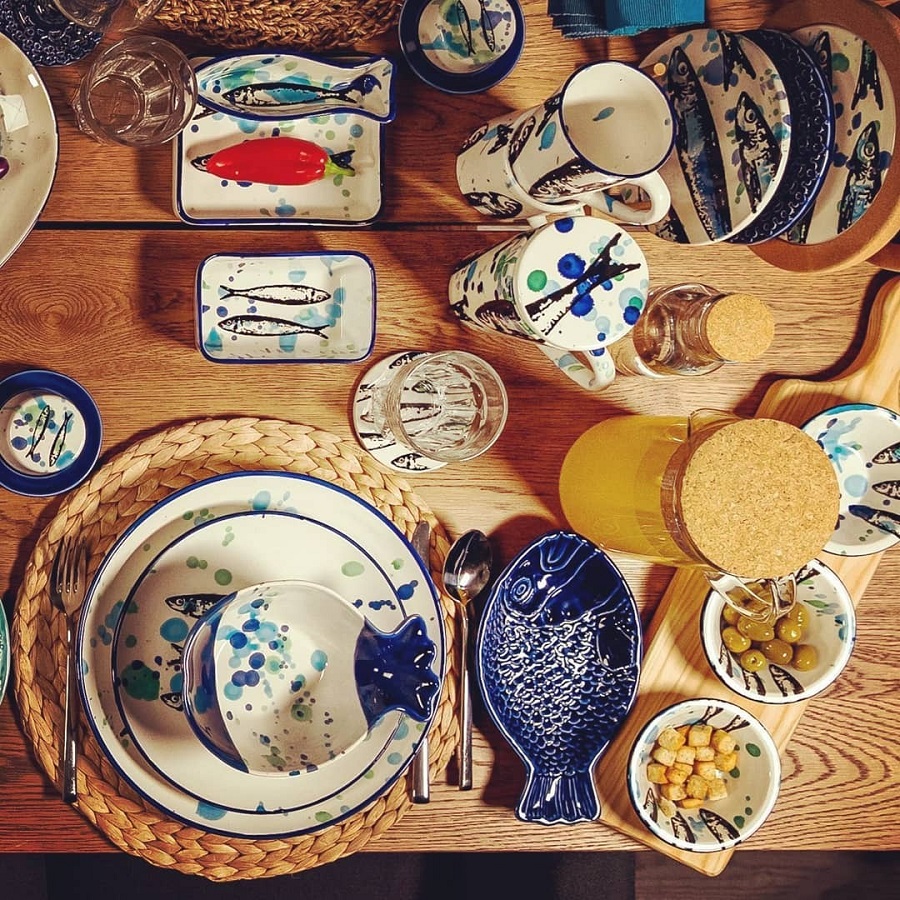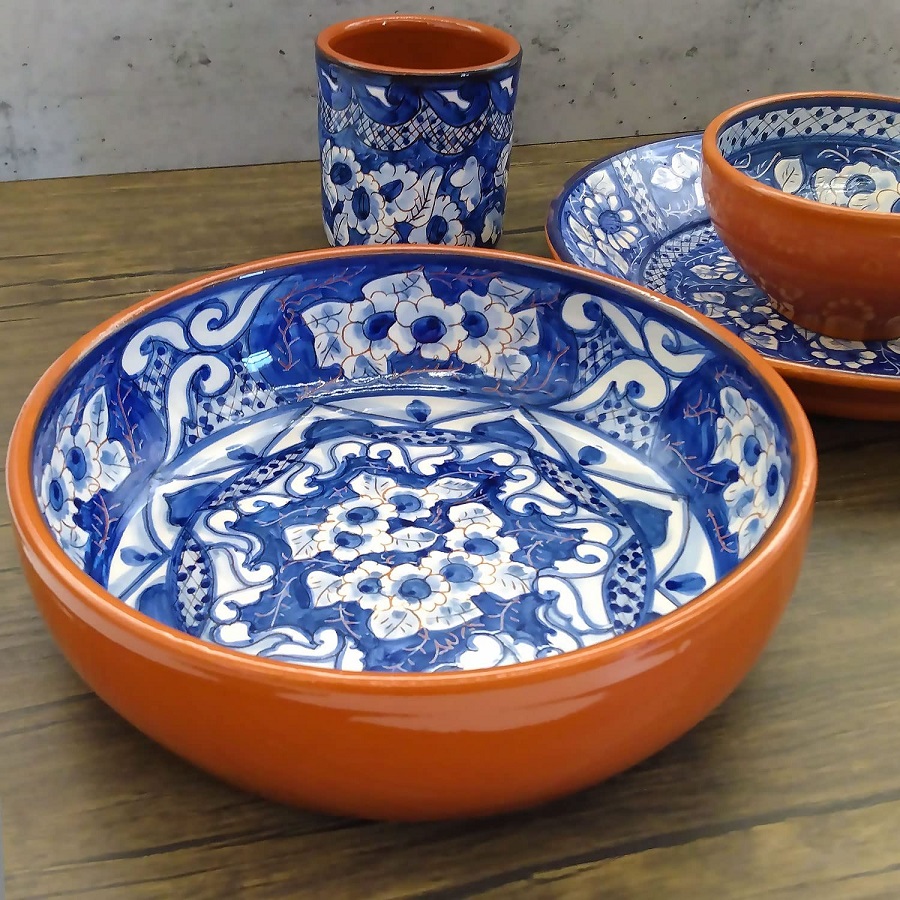The Rich History of Portuguese Ceramics
The story of Portuguese ceramics is as colorful and intricate as the patterns that adorn them. It begins in the Neolithic era. People first shaped clay into functional items during this time. Thousands of years later, the Moors brought their advanced knowledge of ceramics to Portugal. They introduced techniques that forever changed Portuguese pottery.
In the 16th century, the discovery of porcelain by the Portuguese in China ushered in a new era. They began to integrate Asian designs with their own, creating unique styles. Azulejos, the famous blue and white tiles, became a symbol of Portuguese ceramics. These tiles often depict scenes of historical and cultural significance. They have become a hallmark of Portuguese architecture.
During the age of exploration, Portuguese ceramics gained international recognition. Craftsmen incorporated influences from Africa, India, and Brazil into their works. This global exchange enriched the ceramic art form in Portugal, and it thrived.
Each era has contributed to the craft, giving it layers of history and meaning. From ancient techniques to Oriental influences, Portuguese ceramics tell a story of a nation’s past. This history shines in each piece, reflecting Portugal’s long and diverse cultural journey.
Today, the legacy continues. Artisans draw inspiration from the long heritage of their craft. Yet, they are not afraid to innovate and redefine what Portuguese ceramics can be. The history of Portuguese ceramics is not just a tale of the past. It’s a living tradition that evolves with each new generation of artists.

Iconic Styles and Patterns in Portuguese Pottery
Portuguese pottery stands out with its distinctive styles and patterns. Each of these designs reflects a piece of Portugal’s history and cultural influences. Among the most celebrated is the Azulejo tilework. These blue and white tiles don’t just adorn walls, they tell stories. They capture everything from daily life to epic tales of discovery.
Another iconic style is the ‘Barcelos rooster.’ It’s known for its vivid colors and symbolic representation of the Portuguese spirit. The rooster often features in souvenirs and is a staple of Portugal’s folk art.
Floral motifs are also common in Portuguese ceramics. Artists hand paint each petal and leaf with precision. This fine detail showcases Portugal’s rich natural landscapes within their craft.
Swirls and geometric patterns often appear in traditional pottery as well. These designs reflect the influence from Moorish art. Craftsmen meticulously create these patterns, ensuring they are consistent and balanced.
The use of color in Portuguese pottery is equally important. Traditional pieces often feature a warm and earthy palette. These include terracotta, green, and yellow tones. Bright blues and whites contrast these, especially in Azulejo tiles. Modern ceramics may introduce more vibrant colors to this palette.
Portuguese ceramics are not just about aesthetics. They offer a sense of identity and continuity with the past. As symbols of Portugal, these styles and patterns represent a nation’s pride. They carry the legacy of a rich and historical art form forward into modern times.
Regional Variations of Ceramic Art in Portugal
Portugal’s diverse regions contribute unique styles to the country’s ceramic art.
Northern Portugal
In the North, artisans craft pottery known for its rustic and robust qualities. Earthy colors dominate here, reflecting the region’s natural beauty. Traditional pots and kitchenware show this practical approach to ceramics.
Central Portugal
Moving to the central part of Portugal, you find a balance of form and function. Caldas da Rainha is famous for its whimsical and humorous creations. Cabbage leaf plates and Bordallo Pinheiro pieces stand out for their playful designs.
Southern Portugal
Southern regions like Alentejo offer pieces with smooth lines and soft glazes. They prefer subtle tones, with occasional bursts of color. These ceramics often take inspiration from the sea and local flora.
The Algarve
In the Algarve, pottery reflects its bright, seaside environment. Vibrant colors and complex patterns mirror the lively coastal culture. Algarve ceramics also highlight skilled craftsmanship in tile-making.
These regional styles all play a part in the tapestry of Portuguese ceramics. They embody local stories and traditions, making each piece a geographic signature. The variety ensures collectors always find something unique to treasure. As travelers explore Portugal, regional ceramics add a special touch to their journey.
Contemporary Portuguese Ceramics and Modern Techniques
Portuguese ceramics continue to charm the world, bridging tradition with modern innovation. Today, artists push boundaries using new techniques. They blend timeless patterns with cutting-edge styles. Digital printing on ceramics is one innovation. It allows for intricate designs, once impossible by hand. 3D printing also enters this space, creating complex shapes and textures. Sustainable materials are gaining ground in modern pottery. Eco-friendly glazes and reused clay reduce the craft’s environmental impact. These changes show Portuguese ceramics’ ability to adapt. They honor past methods while embracing the future. This balance keeps Portuguese pottery vibrant and relevant in global art scenes.

Celebrated Portuguese Ceramic Artists and Artisans
Portugal has been home to many talented ceramic artists and artisans throughout its history. These individuals have kept the tradition alive, while also introducing their own creative flare. In the world of Portuguese ceramics, certain names stand out for their significant contributions and unique style.
One such figure is Rafael Bordallo Pinheiro, famed for his artistic earthenware that often features naturalistic themes. His works, particularly the cabbage leaf ceramics, are not only functional but also display a whimsical artistry that makes them collectible. The Bordallo Pinheiro factory continues to produce these beloved designs to this day, maintaining the artist’s legacy.
Another name synonymous with Portuguese ceramic art is Maria Keil, known for redesigning the Lisbon subway’s Azulejo panels with modernist motifs. Her work in the mid-20th century helped to revitalize the traditional Azulejo art form by introducing contemporary aesthetics.
Artistically speaking, Joana Vasconcelos is a modern artist who has gained notoriety for her bold use of ceramics in large-scale installations. While she does not produce ceramics in the traditional sense, her incorporation of ceramic elements has brought attention to the medium within the contemporary art scene.
On a smaller scale, individual artisans across the country keep the fire of tradition lit in their studios. These craftsmen and women often learn the trade passed down through generations, ensuring the continuity of styles and techniques unique to Portuguese ceramics.
It’s also worth noting that many of these artists contribute to the growing sustainable practices in the industry. Through their work, they help to promote environmentally conscious methods that are becoming increasingly important in the world of Portuguese ceramics.
The contributions of these artists and artisans have carved a prominent place for Portuguese ceramics in both national and international art circles. From historical figures to present-day innovators, the talent pool in Portuguese ceramic art is deep and vibrant, ensuring the craft not only endures but flourishes.
The Process of Creating Portuguese Ceramic Pieces
The creation of Portuguese ceramics is a meticulous and artistic process. It starts with the sourcing of local clay, a foundational substance rich with Portugal’s natural essence. Artisans then shape this clay by hand or on a wheel, forming the desired figures and forms. This step is crucial as it defines the piece’s shape and functionality.
Once shaped, the pieces undergo a first firing in a kiln. Here, the raw clay turns into bisque – hard and durable but still porous. The bisque ceramics then receive their artistic touch. Artists paint them with traditional styles or innovative patterns, often leaving their creative mark.
Glazing follows painting, where a layer of vitreous substance is applied. This process adds a glossy finish and seals the paint, preparing the piece for a second firing. The second firing is essential for solidifying the glaze and ensuring durability.
After this, the final product comes to life: a piece of Portuguese ceramics that’s both practical and decorative. Each piece undoubtedly tells a rich story through its unique design and expert craftsmanship.
Throughout the process, quality checks are constant. Craftsmen ensure that each piece meets high standards, fitting the proud legacy of Portuguese ceramics. The entire process represents a harmony of tradition and skill that has been perfected over generations. It’s the careful handcrafting that makes Portuguese ceramics so sought after and revered in the world of pottery.

Sustainable Practices in Portuguese Ceramics Production
Amidst growing environmental concerns, Portuguese ceramics have embraced sustainability. Eco-friendly practices are increasingly vital in the production process. Artisans and manufacturers are adopting measures to reduce their ecological footprint while preserving their craft’s rich heritage.
One key aspect of sustainability is the use of natural and local materials. This helps minimize transportation emissions. Artisans utilize locally-sourced clay, reducing the environmental impact of shipping raw materials. In addition, many studios recycle clay scraps. This ensures minimal waste during manufacturing.
Another sustainable practice is the use of non-toxic glazes. Traditional glazes often contain lead and other harmful chemicals. Today, artisans opt for safer alternatives. These eco-glazes are not only better for the environment but also for the health of the workers.
Energy efficiency is also a focus. Kilns, the ovens used to fire ceramics, are now more efficient. Some even operate on renewable energy sources like solar power. This reduces the carbon footprint of the firing process, which is traditionally energy-intensive.
Water usage is another area of improvement. The ceramics industry typically uses a lot of water. Portuguese producers are implementing water recycling systems to conserve this precious resource. It’s a win for the environment, reducing both consumption and wastewater production.
Beyond these techniques, there’s a push for overall greener studio practices. Workshops are cutting down on plastic use and optimizing packaging for shipping. They aim to use recyclable or biodegradable materials whenever possible.
Portuguese ceramics are not just a cultural treasure. They are now at the forefront of sustainability in the arts. Through innovation and a commitment to the environment, artisans ensure their craft remains as timeless as its patterns. As collectors and enthusiasts seek out Portuguese ceramics, they can now do so with an appreciation for the sustainable efforts behind each piece. These practices help ensure that the beauty of Portuguese ceramics can be enjoyed for generations to come, without compromising the health of our planet.
Finding and Collecting Portuguese Ceramics: A Guide for Enthusiasts
For those drawn to the charm of Portuguese ceramics, beginning a collection can be a rewarding pursuit. Here’s a practical guide to help enthusiasts navigate the world of collecting these unique pieces.
Start with Research
Begin by learning about different styles and historic periods of Portuguese ceramics. Books, websites, and collector forums are great sources. Knowing the hallmarks of authentic pieces will guide your purchases.
Visit Pottery Studios and Workshops
Travel to Portugal and visit local studios. Meet the artisans and see firsthand how they craft the ceramics. It’s an enriching experience.
Attend Ceramics Markets and Fairs
Portugal hosts many markets and fairs featuring ceramics. Here, you can find a wide range of items and often talk to the makers.
Look for Quality and Authenticity
Inspect pieces for craftsmanship quality. Check for artist signatures or marks of authenticity. These details can affect value and collectability.
Understand the Care and Preservation
Ceramics require proper care. Learn about cleaning and storage to preserve their beauty and longevity.
Connect with Other Collectors
Joining a community of collectors can provide valuable insights. Swap stories, tips, and maybe even ceramics.
By following these steps, you can build a meaningful collection of Portuguese ceramics. Each piece carries a slice of history and culture. Start collecting and hold a tangible piece of Portugal’s artistry.